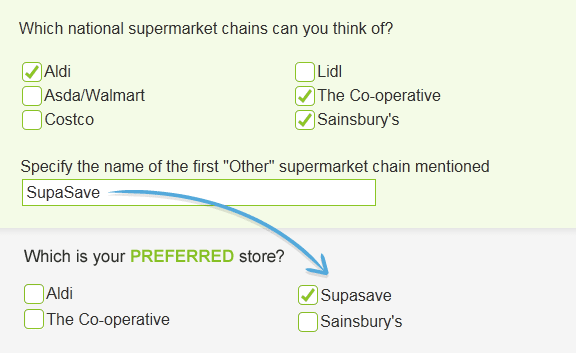Deliver a unique and personalized questionnaire for each participant, and make the interview process feel more like a conversation – with the added bonus of a higher response rate and more accurate data in return.
Dynamic features include:
- Question Routing (or skip logic)
- Text substitution (or piping)
- Database links
- In-survey calculations
- Answer code masking
- Randomization
- Response validation
- Quotas
See key feature list for more information.
Question Routing
You rarely ask every respondent every question. With question routing you can ask questions based on replies, or any combination of replies given earlier in the survey. Routing can be applied to any question, whether qualitative or quantitative and is also active while entering data from paper surveys – so you can always be sure of consistent data.
Text substitution
Feed answers into the question or answer area of subsequent questions. Snap Survey Software text substitution works with both qualitative and quantitative questions, and can be used to create questions with content generated completely from answers previously given.

Database links
Personalize surveys and keep your records up to date. Respondent information held in your database can be inserted anywhere in the survey and can also be used to pre-answer questions. For example:
- Present surveys in a preferred language.
- Include address and other personal information in the surveys.
- Pre-populate the survey with known information.
- Automatically update your database with new or amended information from the survey.
In-survey calculations
Snap can perform calculations as the survey is being completed, creating tailor made questionnaires for each participant. Example uses might include:
- Tailoring a greeting according to the current time of day.
- Using participant date of birth to calculate age now or on a specific future date.
- Displaying an appropriate “thank you” page according to participant age or gender.
- Calculating and presenting quiz scores.

Answer Masking
Display or hide individual answers for multiple choice questions. Many questions involve choosing a first answer, followed by a second, and then perhaps a third. Masking ensures accuracy by hiding the first choice option when requesting a second choice option, and so on.
Randomization
Bias can be a problem in any survey. Randomization helps to avoid this by changing or reordering survey content for each participant:
- Randomly present individual pages of a questionnaire.
- Randomly select questions from a pool.
- Randomly order questions in a grid, such as rating scale questions.
- Randomly order answer codes in a multiple choice question.
Response validation
Ensure the survey is intuitive to complete and you get the accurate information you need. Options include:
- Making questions mandatory.
- Setting multiple choice questions to allow single or multiple replies, with the further option to set a minimum or maximum number of replies.
- Configuring questions to accept only specific values or range of values, for example, numbers, dates or times.
- Applying patterns to ensure that responses are entered in a specific format, for example, zip codes, email address or employee IDs.
Quotas
Control how many respondents within a particular group are interviewed. Specific limits can be linked to an individual question, or a combination of questions, for example males, or males over 40.
See full feature list for more information.